Penjor Bali, The Sacred Symbol of Prosperity
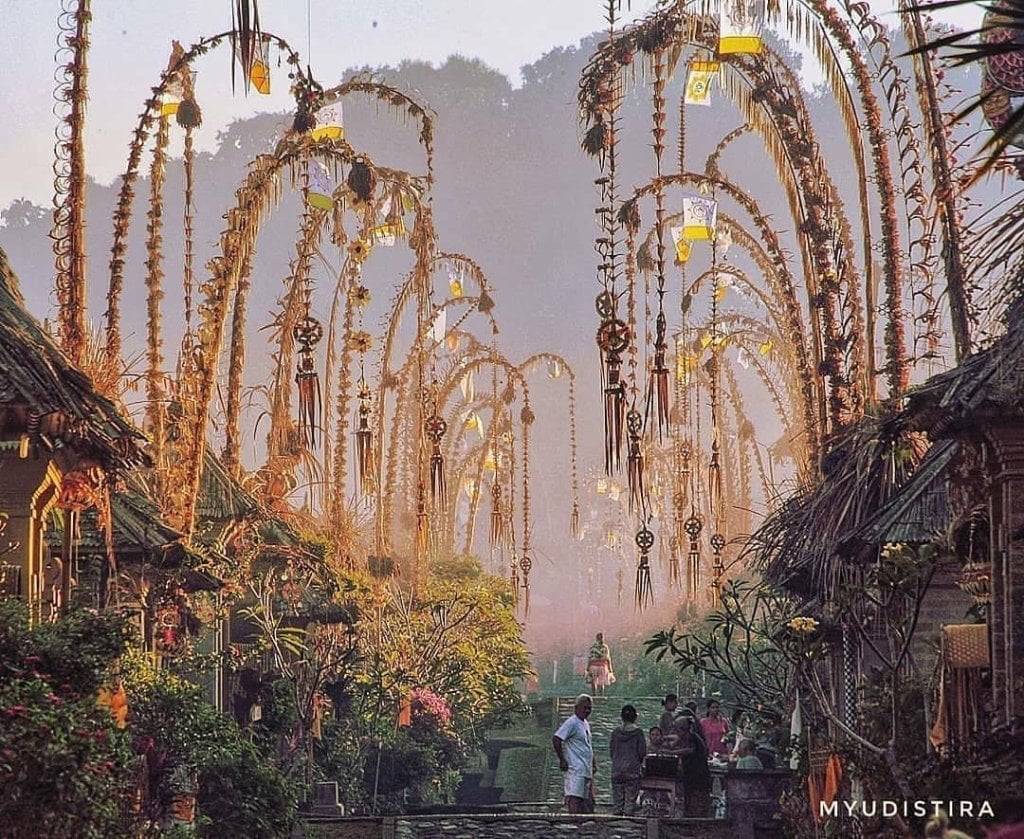
Penjor Bali, the “Island of the Gods,” is not only known for its breathtaking natural landscapes, pristine beaches, and rich culture but also for its deep-rooted spiritual traditions. One of the most iconic and visible elements of Balinese religious and cultural practices is the Penjor, a tall, gracefully arched bamboo pole adorned with coconut leaves, rice, fruits, and other symbolic items. These beautiful structures are more than just decoration—they hold deep significance in Balinese Hindu rituals, symbolizing devotion, gratitude, and the balance between heaven and earth.
What is Penjor?
A Penjor is a long bamboo pole, typically reaching up to 8 to 10 meters in height, which is elaborately decorated with natural elements such as young coconut leaves, rice, fruits, and flowers. These offerings are carefully arranged to create an intricate and meaningful structure. At the very top of the pole, a sampian (a decorative element made from palm leaves) is placed, while the rest of the pole is adorned with various other items like janur (young coconut leaves), buah-buahan (fruits), and umbul-umbul (small flags).
Penjor is traditionally erected during the Galungan and Kuningan celebrations, which are among the most important religious festivals in the Balinese Hindu calendar. However, Penjor can also be seen at other special occasions, such as temple ceremonies (Odalan), weddings, or house blessings. The purpose of the Penjor is to express gratitude to the gods, particularly to Dewa Indra, the god of rain and prosperity, for the blessings of the earth.
The Symbolism of Penjor
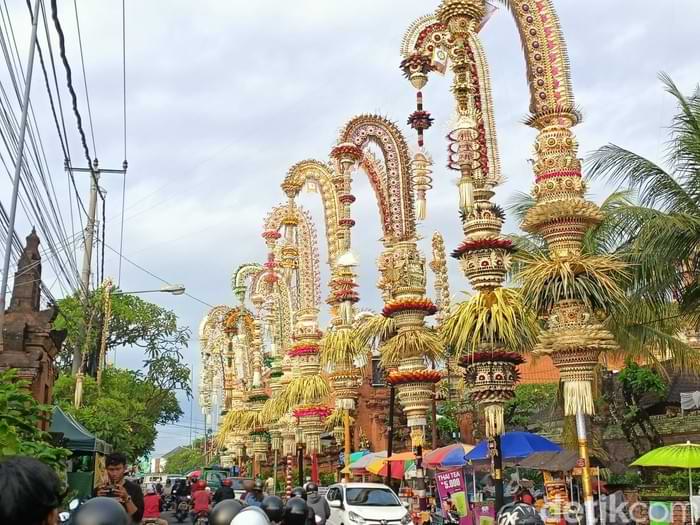
The Penjor is more than just an artistic display—it is rich in symbolic meaning. Each element of the Penjor represents various aspects of life, nature, and spirituality in Balinese culture.
- Bamboo Pole: The long, tall bamboo pole represents Mount Agung, the sacred mountain in Bali, which is considered the home of the gods. Mount Agung is also seen as a symbol of balance between the physical and spiritual realms, connecting the earth to the heavens.
- Young Coconut Leaves (Janur): The coconut leaves are used to decorate the Penjor in elaborate patterns. They represent purity and new beginnings. The leaves are also symbolic of fertility and life, as the coconut tree is considered a source of sustenance in Balinese society.
- Rice and Fruits: The offerings of rice and fruits placed on the Penjor symbolize prosperity and abundance. Rice, the staple food of the Balinese, represents sustenance, while the fruits signify the harvest and the blessings of nature. These offerings are made in gratitude for the bounty of the earth.
- Flowers: Flowers are included to represent beauty, purity, and devotion. They are offered to the gods as a sign of respect and are an important part of every Balinese Hindu offering.
- Flags (Umbul-umbul): Small flags placed on the Penjor represent victory and are often used during celebrations. They flutter in the wind, adding a dynamic and lively element to the Penjor, which is meant to draw attention and invite the presence of the gods.
- Sampian: The intricate top piece of the Penjor is crafted from palm leaves, and its shape is meant to represent the divine. The sampian is the final and most important decorative element, symbolizing the highest offering to the gods.
Together, these elements make the Penjor a powerful symbol of devotion, gratitude, and the harmonious relationship between humans, nature, and the divine. It embodies the Balinese concept of Tri Hita Karana, the philosophy of maintaining balance and harmony between the three essential elements of life: humanity, the natural world, and the divine.
Penjor in Galungan and Kuningan Celebrations
Penjor plays a central role in the Galungan and Kuningan festivals, two of the most important religious events in Bali. These festivals celebrate the victory of dharma (good) over adharma (evil), and they mark a period when ancestral spirits return to visit their descendants.
Galungan occurs every 210 days in the Balinese Pawukon calendar and lasts for 10 days. During this time, Penjor are erected in front of homes, temples, and businesses across the island, lining the streets with their tall, elegant forms. The sight of Penjor stretching as far as the eye can see is one of the most iconic and visually striking aspects of Bali during Galungan.
Each household in Bali erects a Penjor in front of their house as an offering to the gods and a way to express gratitude for the blessings of life, health, and prosperity. The Penjor is usually installed on Penampahan Galungan, the day before Galungan, and remains standing for the entire duration of the festival, culminating in Kuningan, which marks the day when the ancestral spirits return to the heavens.
The process of creating a Penjor is a communal activity, often involving family members or the entire village. Each Penjor is unique, with families putting their personal touch on the decorations, reflecting both their creativity and devotion.
How Penjor is Made
Creating a Penjor is a meticulous process that requires both skill and creativity. Traditionally, the construction of the Penjor begins several days before the Galungan festival.
- Bamboo Selection: The first step is selecting a tall and sturdy bamboo pole, which forms the backbone of the Penjor. The bamboo must be strong enough to withstand wind and rain while supporting the weight of the decorations and offerings.
- Decorating with Janur: The young coconut leaves, or janur, are intricately woven into various shapes and patterns. These decorative elements are tied along the length of the bamboo pole and serve to beautify the Penjor while also representing purity and fertility.
- Adding Offerings: Offerings such as rice, fruits, and flowers are placed on small bamboo platforms attached to the Penjor. These offerings are essential in Balinese Hindu rituals, as they symbolize gratitude for the blessings received and ask for protection and prosperity.
- Placement of the Sampian: The decorative sampian is placed at the top of the Penjor, completing the structure. This piece is carefully crafted from palm leaves and is often the most elaborate part of the Penjor.
Once the Penjor is complete, it is erected outside the home or temple. A small shrine is often placed at the base of the Penjor, where additional offerings of food, incense, and flowers are made during the Galungan and Kuningan celebrations.
Penjor Beyond Galungan and Kuningan
While Penjor is most commonly associated with Galungan and Kuningan, they are also used in other important ceremonies throughout the year. For example, Penjor may be erected during Odalan (temple anniversary ceremonies), weddings, or house blessing ceremonies. In these contexts, Penjor serves as a symbol of gratitude to the gods and a way to ensure blessings for the occasion.
The Evolution of Penjor in Modern Bali
While the traditional Penjor remains an integral part of Balinese culture, modern influences have also made their way into the design and construction of Penjor. Today, some Penjor incorporate more elaborate decorations, including colorful fabrics, metallic ornaments, and LED lights. In tourist areas, Penjor may also be used as decorative elements during cultural events or festivals, showcasing the island’s artistic heritage.
Despite these modern adaptations, the core symbolism and spiritual significance of Penjor remain unchanged. Whether simple or ornate, each Penjor stands as a testament to Bali’s enduring connection to nature, tradition, and the divine.
Conclusion
The Penjor is more than just a decorative feature in Bali’s religious and cultural landscape—it is a powerful symbol of faith, gratitude, and the balance between humanity and the divine. Erected during key religious festivals like Galungan and Kuningan, the Penjor represents the core of Balinese spirituality and the deep connection between the people of Bali and their environment.
To witness the beauty of Penjor is to experience the heart of Bali’s cultural and religious traditions. The sight of these elegant bamboo poles lining the streets during festive occasions is a reminder of the island’s unique heritage, one that blends the natural, the spiritual, and the communal into a harmonious whole.
Whether you’re a visitor or a local, the Penjor serves as a symbol of the blessings that Bali offers to those who seek its beauty, tranquility, and spiritual.


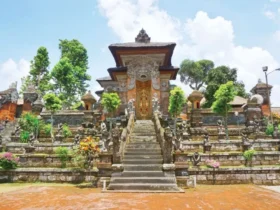
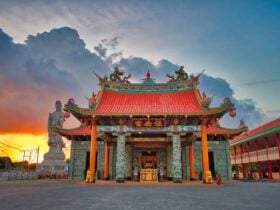
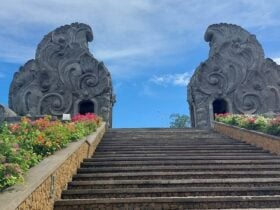




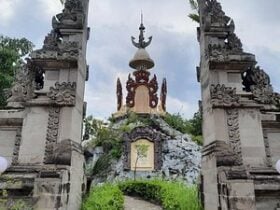
Leave a Review